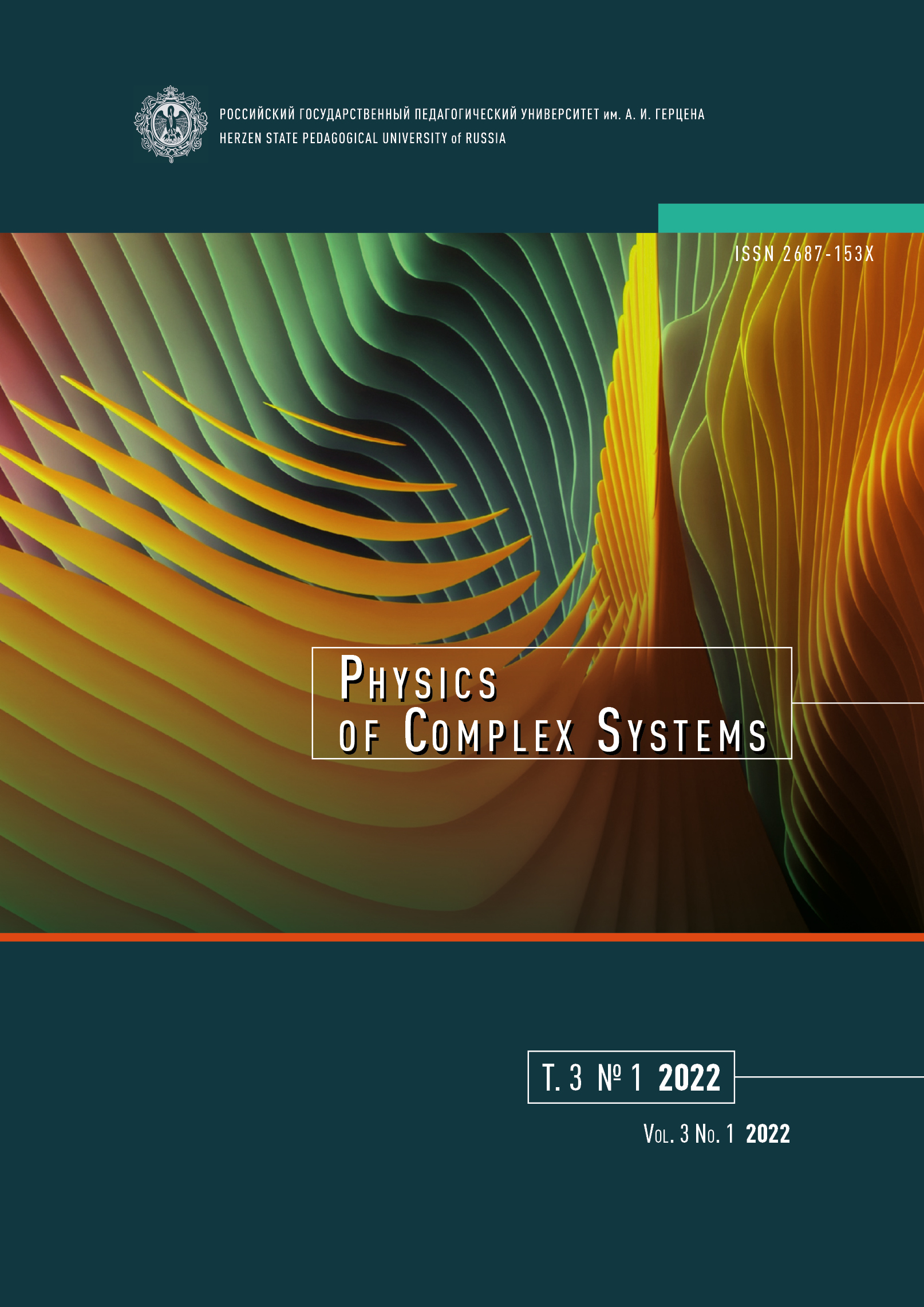Application of the complex electrical module method for the determination of the relaxation parameters of dielectrics with high electrical conductivity
DOI:
https://doi.org/10.33910/2687-153X-2022-3-1-11-20Keywords:
electrical module, relaxation parameters, the Havriliak–Negami equation for the electrical moduleAbstract
The paper submits that the method of a complex electrical module allows to investigate the characteristics of relaxation processes in dielectrics having high electrical conductivity. The method makes it possible to determine the relaxation parameters of dielectrics when relaxation peaks are absent in the frequency dependence of dielectric losses ε”(f). In turn, relaxation peaks can be detected on the frequency dependences M”(f). In addition, a function graph M’(f) is plotted. Simultaneous approximation of the curves M”(f) and M’(f) in the frequency range corresponding to the maximum M” by the Havriliak–Negami equation for the electrical module makes it possible to determine the relaxation parameters α, β, τ0.
References
Annus, P., Min, M. (eds.). (2021) Bioimpedance and Spectroscopy. London: Academic Press, 452 p. (In English)
Asami, K. (2002) Characterization of biological cells by dielectric spectroscopy. Journal of Non-Crystalline Solids, 305 (1–3), 268–277. https://doi.org/10.1016/S0022-3093(02)01110-9 (accessed 15.10.2021). (In English)
Avanesyan, V. T., Salnikova, Zh. A. (2020) Electric modulus spectroscopy of PA6/PA66 aliphatic polyamide. In: Yu. Gorokhovatsky, D. Temnov, V. Kapralova (eds.). AIP Conference Proceedings. Vol. 2308. Proceedings of The XV International Conference “Physics of dielectrics” (St. Petersburg, Russia, 5–8 October 2020). [S. l.]: AIP Publ., article 030013. [Online]. Available at: https://doi.org/10.1063/5.0035258 (accessed 15.10.2021). (In English)
Castro, R. A., Ignatiev, A. I., Nikonorov, N. V. et al. (2017). Dielectric properties of silver-containing photo-thermo-refractive glass in temperature range of − 50 to + 250 °C: The role of hybrid molecular clusters. Journal of Non- Crystalline Solids, 461, 72–79. https://doi.org/10.1016/j.jnoncrysol.2017.01.041 (In English)
Chelidze, T. (2002) Dielectric spectroscopy of blood. Journal of Non-Crystalline Solids, 305 (1–3), 285–294. https://doi.org/10.1016/S0022-3093(02)01101-8 (accessed 15.10.2021) (In English)
Havriliak, S., Negami, S. (1966) A complex plane analysis of α-dispersions in some polymer systems. Journal of Polymer Science Part C: Polymer Symposia, 14 (1), 99–117. https://doi.org/10.1002/polc.5070140111 (In English)
Kremer, K., Schonhals, A. (eds.). (2002) Broadband dielectric spectroscopy (accessed 15.10.2021) (In English)
McCrum, N. G., Read, B. E., Williams, G. (1967) Anealastic and dielectric effecrts in polymeric solids. London: Willey Publ., 617 р., https://doi.org/10.1002/app.1969.070130214 (In English)
Nikonorova, N. A., Balakina, M. Y., Fominykh, O. D. et al. (2016) Dielectric spectroscopy and molecular modeling of branched methacrylic (co)polymers containing nonlinear optical chromophores. Materials Chemistry and Physics, 181, 217–226. https://doi.org/10.1016/j.matchemphys.2016.06.052 (In English)
Nikonorova, N. A., Kononov, A. A., Dao, H. T., Castro, R. A. (2019) Molecular mobility of thermoplastic aromatic polyimides studied by dielectric spectroscopy. Journal of Non-Crystalline Solids, 511, 109–114. https://doi.org/10.1016/j.jnoncrysol.2018.12.032 (In English)
Raicu, V., Feldman, Y. (eds.). (2015) Dielectric relaxation in biological systems: Physical principles, methods, and applications. Oxford: Oxford University Press, 432 p. (In English)
Romanov, A. N., Vinokurova, E. Yu., Kovrigin, A. O. et al. (2008) Dielektricheskie kharakteristiki biologicheskikh zhidkostej cheloveka pri razvitii onkologicheskikh zabolevanij [Dielectric characteristics of human biological fluids in the development of oncological diseases]. Barnaul: Azbuka Publ., 72 p. (In Russian)
Rychkov, A. A., Rychkov, D. A., Trifonov, S. A. (2005) Polimernye dielektriki [Polymer dielectrics]. Saint Petersburg: Knizhnyj Dom Publ., 156 р. (In Russian)
Salnikova, Zh. A., Kononov, A. A. (2020) Derivation of the Havriliak—Negami equation for the complex electrical modulus. In: Yu. Gorokhovatsky, D. Temnov, V. Kapralova (eds.). AIP Conference Proceedings. Vol. 2308. Proceedings of The XV International Conference “Physics of dielectrics” (St. Petersburg, Russia, 5–8 October 2020). [S. l.]: AIP Publ., article 030017. [Online]. Available at: https://doi.org/10.1063/5.0034028 (accessed 15.10.2021). (In English)
Salnikova, Zh. A., Plotnikova, L. V., Smirnov, A. P. et al. (2020a) Dielectric spectroscopy of blood serum of patients with chronic lymphocytic leukemia. In: Yu. Gorokhovatsky, D. Temnov, V. Kapralova (eds.). AIP Conference Proceedings. Vol. 2308. Proceedings of The XV International Conference “Physics of dielectrics” (St. Petersburg, Russia, 5–8 October 2020). [S. l.]: AIP Publ., article 030018. [Online]. Available at: https://doi.org/10.1063/5.0035270 (accessed 15.10.2021) (In English)
Salnikova, Zh. A., Plotnikova, L. V., Smirnov, A. P. et. al. (2020b) Diagramma Koul-Koula elektricheskogo modulya syvorotki krovi bol’nykh khronicheskim limfolejkozom [Cole-Cole diagram of the electrical module of blood serum of patients with chronic lymphocytic leukemia]. In: Materialy 54-j shkoly PIYaF po fizike kondensirovannogo sostoyaniya (16–20 Marta 2020 g.) [Materials of the 54th PNPI School on Condensed Matter Physics (16–20. March 2020)]. Saint Petersburg: NRC “Kurchatov Institute”—PNPI Publ., p. 157 (In Russian)
Sazhin, B. I. (ed.). (1977) Elektricheskie svojstva polimerov [Electrical properties of polymers]. 2nd ed. Leningrad: Khimiya Publ., 192 р. (In Russian)
Wolf, M., Gulich, R., Lunkenheimer, P. et al. (2011) Broadband dielectric spectroscopy on human blood. Biochimica et Biophysica Acta (BBA)—General Subjects, 1810 (8), 727–740. https://doi.org/10.1016/j.bbagen.2011.05.012 (In English)
Downloads
Published
Issue
Section
License
Copyright (c) 2022 Zhanna A. Salnikova, Alexey A. Kononov, Alexander P. Smirnov, Rene Alejandro Castro Arata

This work is licensed under a Creative Commons Attribution-NonCommercial 4.0 International License.
The work is provided under the terms of the Public Offer and of Creative Commons public license Creative Commons Attribution 4.0 International (CC BY 4.0).
This license permits an unlimited number of users to copy and redistribute the material in any medium or format, and to remix, transform, and build upon the material for any purpose, including commercial use.
This license retains copyright for the authors but allows others to freely distribute, use, and adapt the work, on the mandatory condition that appropriate credit is given. Users must provide a correct link to the original publication in our journal, cite the authors' names, and indicate if any changes were made.
Copyright remains with the authors. The CC BY 4.0 license does not transfer rights to third parties but rather grants users prior permission for use, provided the attribution condition is met. Any use of the work will be governed by the terms of this license.







